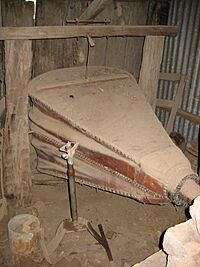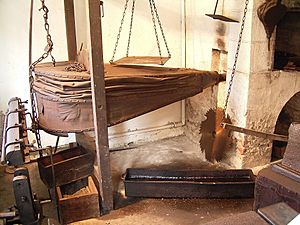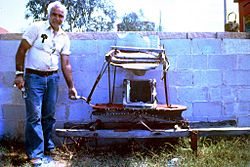Bellows facts for kids
A bellows is a clever tool that blows air into a small space to make something work. It has a special bag or chamber that holds air. When you squeeze or push the bellows, the air inside is forced out.
Bellows can be small enough to hold in your hand, like those used to help a fire burn brighter in a fireplace. They can also be very large, like the ones that push air into a huge pipe organ so it can play music. In the past, people had to pump large bellows by hand, sometimes even several people at once! But today, electricity often does the job.

Blacksmiths and other metalworkers use bellows to make fires hot enough for smelting (melting metal) and welding (joining metal). Bellows are also found in many musical instruments. These include bagpipes, accordions, and concertinas. The harmonium has bellows that the player pumps with their feet.
Contents
What's in a Name?
The word "bellows" is always used as a plural, even if you're talking about just one! Think of it like "scissors" or "pants." The name comes from an Old English word that meant "blowing-bag." It's even related to the word "belly" because both refer to something that can be filled with air or contents.
Bellows in Metalworking


Many important processes, like melting iron (smelting) and welding, need a lot of heat. These methods could only be developed after people invented the bellows in ancient times. Bellows help by sending extra air to the fuel, which makes the fire burn much hotter and faster.
Different kinds of bellows have been used in metalworking:
- Box bellows are common in Asia.
- Pot bellows were used in ancient Egypt.
- Tatara foot bellows come from Japan.
- Accordion bellows have pleated sides and have been used in Europe for centuries.
- Piston bellows were developed in Europe in the 1700s. However, the Chinese had double-action piston bellows as early as the 3rd century BC!
- Metal bellows are used in modern machines to handle movement.
The Chinese engineer Du Shi (who lived around 38 AD) was the first to use water power to operate bellows for metalworking. He used a waterwheel to power piston bellows for cast iron furnaces. The ancient Greeks and ancient Romans also used bellows in their furnaces to make wrought iron.
Today, large bellows are often replaced by electric fans or blowers in factories.
How Double-Acting Piston Bellows Work
Double-acting piston bellows are special bellows used by blacksmiths and metal smelters. They are designed to blow air out on both the push and pull strokes of the handle. This is different from simpler bellows that only blow air in one direction and refill in the other. Because they blow air constantly, they create a stronger and more steady blast of air for the forge.
These bellows were invented in China around the 5th century BC and arrived in Europe by the 1500s.
Inside a rectangular box, there's a piston that moves back and forth. The edges of the piston are sealed with materials like feathers or fur to keep the air from leaking out. When you pull the piston, air enters from one side and is pushed out through a nozzle. When you push the piston, air enters from the opposite side and is also pushed out through the same nozzle.
How Double-Lung Accordion Bellows Work
These bellows have three main parts, or "leaves." The middle leaf stays still. The bottom leaf moves up and down. The top leaf can move freely and has a weight on it. The bottom and middle leaves have special valves, but the top one doesn't. Only the top part is connected to the air spout.
When the bottom leaf is pushed up, air is pumped from the bottom part into the top part. At the same time, air is leaving the bellows through the spout, but more slowly. This makes the top part inflate. Then, the bottom leaf is moved down to pull fresh air into the bellows. While this happens, the weight on the top leaf pushes it down, so air keeps flowing out through the spout.
This design doesn't necessarily blow more air, but it provides a much more constant and even flow of air compared to simple bellows or even two simple bellows pumped one after another.
Other Uses for Bellows
Bellows are used in many different ways:
- Medical equipment: Bellows are a key part of anesthesia machines used in hospitals.
- Clocks: Cuckoo clocks use tiny bellows to blow air through pipes, making the sound of a cuckoo bird.
- Musical instruments: Many instruments rely on bellows to provide or control air pressure:
* Melodeons, concertinas, and similar instruments * Reed organs * Pipe organs * Some types of bagpipes * Harmoniums and melodeons * Portative organs (small, portable organs)
Accordion-Like Uses (Not for Air)
Sometimes, the word "bellows" is used for things that look like an accordion but don't actually move air.
- Industrial protection: Bellows are used in factories and machines to protect moving parts like rods and bearings from dirt and dust.
- Vehicle joints: You can see bellows on articulated buses and trams. They cover the bendy joint where the vehicle connects, allowing it to turn.
- Flexible tubing: Bellows-like tubing is lightweight and flexible. It can be used to deliver gases or air at normal pressure, like in some early diving equipment.
- Cameras: Folding and view cameras use bellows to block out light. This allows the lens to move closer or further from the film, helping to focus the image and control how it looks.
- Piping expansion joints: In large piping systems that carry hot liquids or gases (like steam), bellows are used to absorb movement caused by heat changes and vibrations.
Images for kids
-
A large bellows creates a mushroom cloud at the Exploratorium in San Francisco, California.
See also
 In Spanish: Fuelle (neumático) para niños
In Spanish: Fuelle (neumático) para niños





